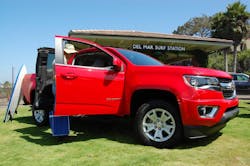Believe it or not, “tripping” in this case is an engineering term related to vehicle aerodynamics; essentially, how to make air literally “trip” off the many edges of a truck to reduce drag and thus boost fuel economy.
Jeff Perkins, director of truck exteriors for General Motors, walked me through why “tripping” is a key yet almost invisible advantage to the new 2015 GMC Canyon and Chevrolet Colorado midsize pickups the OEM is showing off this week at a ride and drive event in Del Mar, CA.
[You can view more photos from this event by clicking here.]
“Fuel economy is a major focus in the design of these new pickups,” he explained. “It influenced the use of materials, engine design and of course how we approached aerodynamics.”
Perkins and his team spent hundreds of wind tunnel testing hours fine-tuning the exterior of the new 2015 Canyon and Colorado models; developing ways to get air to “trip” off the many exterior edges of the vehicle as well channel it around the under carriage and wheels.This photo gallery highlights some of the key spots on GM’s new midsize pickups where such “tripping” occurs: on top of the cab, at the rear tail lights, etc.
“It’s all about preventing the formation of air turbulence under the vehicle, in the cargo bed, and right behind the tailgate, so we reduce the air resistance facing these pickups as they travel down the road,” Perkins told me.
“Each fine-tuning effort we make has a lot of impact on the vehicle’s overall coefficient of drag,” he added. “While the improvements gained by each of those ‘aero enablers’ is hard to quantify, they all add up to about a 1 mile per gallon (mpg) worth of fuel saving at highway speeds.”
And while 1 mpg may not seem like a lot to many, over time, such fuel savings puts money back into the fleet operator’s pocket. Not something to sniff at even with fuel prices projected to decline in the near future.


